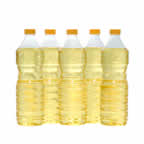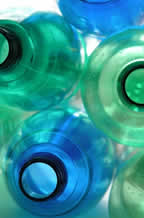
PET (also abbreviated PETE) is short for polyethylene terephthalate, the chemical name for polyester.
PET is a clear, strong, and lightweight plastic that is widely used for packaging foods and beverages, especially convenience-sized soft drinks, juices and water. Virtually all single-serving and 2-liter bottles of carbonated soft drinks and water sold in the U.S. are made from PET.
It is also popular for packaging salad dressings, peanut butter, cooking oils, mouthwash, shampoo, liquid hand soap, window cleaner, even tennis balls. Special grades of PET are used for carry-home food containers and prepared food trays that can be warmed in the oven or microwave.
The basic building blocks of PET are ethylene glycol and terephthalic acid, which are combined to form a polymer chain. The resulting spaghetti-like strands of PET are extruded, quickly cooled, and cut into small pellets. The resin pellets are then heated to a molten liquid that can be easily extruded or molded into items of practically any shape.
PET was first synthesized in North America in the mid-1940s by DuPont chemists searching for new synthetic fibers. DuPont later branded its PET fiber as “Dacron.” Today, more than half of the world’s synthetic fiber is made from PET, which is called “polyester” when used for fiber or fabric applications. When used for containers and other purposes, it is called PET or PET resin.
In the late 1950s, researchers found a way to stretch a thin extruded sheet of PET in two directions to create PET film, which is now used extensively for video, photo and packaging films. In the early 1970s, the technology was developed for blow-stretch molding PET into bottles. The PET bottle was patented in 1973.
Global Safety Approval

PET is approved as safe for contact with foods and beverages by the FDA and health-safety agencies throughout the world. The safety of PET for food, beverage, pharmaceutical and medical applications has been repeatedly demonstrated through extensive studies, regulatory approvals, testing, and its widespread acceptance for more than 30 years. PET does not contain bisphenol-A (BPA) or phthalates (plasticizers).
Because of PET’s unique properties, it is rapidly becoming the world’s preferred packaging material for foods and beverages. Like glass, it is a very strong and inert material that does not react with foods, is resistant to attack by micro-organisms, and will not biologically degrade. But unlike glass, PET is extremely lightweight, easy and efficient to transport, and shatterproof.
Fully Recyclable
PET is completely recyclable, and is the most recycled plastic in the U.S and worldwide. More than 1.5 billion pounds of used PET bottles and containers are recovered in the United States each year for recycling. PET can easily be identified by the #1 in the triangular “chasing arrows” code, which is usually found molded into the bottom or side of the container. No other plastic carries the #1 code.
PET can be commercially recycled by thorough washing and re-melting, or by chemically breaking it down to its component materials to make new PET resin. Almost every municipal recycling program in North America and Europe accepts PET containers.

Products commonly made from recycled PET include new PET bottles and jars, carpet, clothing, industrial strapping, rope, automotive parts, fiberfill for winter jackets and sleeping bags, construction materials, and protective packaging.
The current U.S. recycling rate for PET is 31%. This figure continues to grow, but notably lags behind Europe, which has a PET recycling rate of 52%.
Although recycling is the most environmentally responsible and efficient re-use of resources, PET bottles and containers that find their way to the landfill pose no risk of harm or leaching. Since the polymer is inert, it is resistant to attack by micro-organisms, and won’t biologically degrade. PET also takes up relatively little landfill space since it is easily crushed flat. According to the EPA, only 1% of U.S. municipal solid waste is due to PET containers.
Sustainable
PET is a very energy-efficient packaging material. Although its raw materials are derived from crude oil and natural gas, it enjoys a very favorable sustainability profile in comparison to glass, aluminum and other container materials.
Its sustainability jumps even higher when recycling is introduced, since approximately 40% of PET’s energy use is attributable to its “resource energy” – the energy inherently trapped in its raw materials that can be recaptured and reused through recycling.
The high strength of PET in comparison to its light weight is a major key to its energy efficiency, allowing for more product to be delivered in less packaging and using less fuel for transport. Ongoing advances in light-weighting technology continue to improve its energy efficiency even further. Life cycle studies of PET have consistently confirmed the environmental benefits of PET as a packaging material.
In the 60 years since PET was first synthesized, it has become one of the world’s most widely used, versatile and trusted materials.
